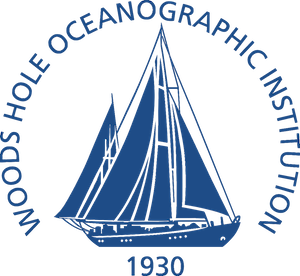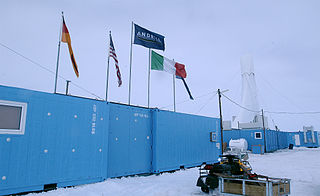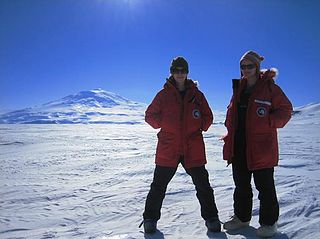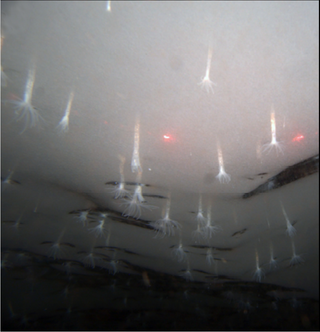Related Research Articles

The Woods Hole Oceanographic Institution is a private, nonprofit research and higher education facility dedicated to the study of marine science and engineering.

The Ross Sea is a deep bay of the Southern Ocean in Antarctica, between Victoria Land and Marie Byrd Land and within the Ross Embayment, and is the southernmost sea on Earth. It derives its name from the British explorer James Clark Ross who visited this area in 1841. To the west of the sea lies Ross Island and Victoria Land, to the east Roosevelt Island and Edward VII Peninsula in Marie Byrd Land, while the southernmost part is covered by the Ross Ice Shelf, and is about 200 miles (320 km) from the South Pole. Its boundaries and area have been defined by the New Zealand National Institute of Water and Atmospheric Research as having an area of 637,000 square kilometres (246,000 sq mi).

Palmer Station is a United States research station in Antarctica located on Anvers Island, the only US station located north of the Antarctic Circle. Initial construction of the station finished in 1968. The station, like the other U.S. Antarctic stations, is operated by the United States Antarctic Program (USAP) of the National Science Foundation. The base is about as distant from the equator as Fairbanks, Alaska.

Frank Sherwood "Sherry" Rowland was an American Nobel laureate and a professor of chemistry at the University of California, Irvine. His research was on atmospheric chemistry and chemical kinetics. His best-known work was the discovery that chlorofluorocarbons contribute to ozone depletion.

The Deep Sea Drilling Project (DSDP) was an ocean drilling project operated from 1968 to 1983. The program was a success, as evidenced by the data and publications that have resulted from it. The data are now hosted by Texas A&M University, although the program was coordinated by the Scripps Institution of Oceanography at the University of California, San Diego. DSDP provided crucial data to support the seafloor spreading hypothesis and helped to prove the theory of plate tectonics. DSDP was the first of three international scientific ocean drilling programs that have operated over more than 40 years. It was followed by the Ocean Drilling Program (ODP) in 1985, the Integrated Ocean Drilling Program in 2004 and the present International Ocean Discovery Program in 2013.

The Moss Landing Marine Laboratories (MLML) is a multi-campus marine research consortium of the California State University System, headquartered at Moss Landing, California.

The Index to Marine & Lacustrine Geological Samples is a collaboration between multiple institutions and agencies that operate geological sample repositories. The purpose of the database is to help researchers locate sea floor and lakebed cores, grabs, dredges, and drill samples in their collections.

Maria Vasilyevna Klenova was a Russian and Soviet marine geologist and one of the founders of Russian marine science and contributor to the first Soviet Antarctic atlas.

Timothy Raymond Naish is a New Zealand glaciologist and climate scientist who has been a researcher and lecturer at Victoria University of Wellington and the Director of the Antarctic Research Centre, and in 2020 became a programme leader at the Antarctic Science Platform. Naish has researched and written about the possible effect of melting ice sheets in Antarctica on global sea levels due to high CO2 emissions causing warming in the Southern Ocean. He was instrumental in establishing and leading the Antarctica Drilling Project (ANDRILL), and a Lead Author on the Intergovernmental Panel on Climate Change (IPCC) 5th Assessment Report (2014).

ANDRILL is a scientific drilling project in Antarctica gathering information about past periods of global warming and cooling.
David A. Hodell is a geologist and paleoclimatologist. He currently holds the position of Woodwardian Professor of Geology in the Department of Earth Sciences at the University of Cambridge, where he is also a fellow of Clare College. He is a dual citizen of the United Kingdom and the United States. Previously, he taught at the University of Florida from 1986–2008, earning the rank of full professor in geological sciences. Hodell was also the director of the Stable Isotope Laboratory from 1996–2008. Hodell earned his Ph.D. in 1986 in oceanography from the University of Rhode Island after earning his bachelor of arts in 1980 in geology from the University of Vermont.

Kelly Jemison is an American academic geologist specializing in Antarctic diatoms. She studied at Florida State University, participated in the ANDRILL Project, and in 2011 was awarded the Antarctica Service Medal. She currently works as a Geologist for Bureau of Ocean Energy Management in Anchorage, Alaska.

Edwardsiella andrillae is a species of sea anemone that uniquely lives anchored to the underside of sea ice offshore of Antarctica. It was discovered in December 2010 during a test run of an undersea robot by a team of researchers associated with the Antarctic Geological Drilling (ANDRILL) Program. The newly discovered anemone was named for the aforementioned program.
Wise Ridge is a sharp-crested ridge, 4 nautical miles (7.4 km) long, extending southwest to northeast between Dahe Glacier and Willis Glacier in the Saint Johns Range of Victoria Land. Peaks on the ridge rise 1,200 m (3,900 ft) to 1,525 m (5,003 ft) above sea level. It was named by the Advisory Committee on Antarctic Names in 2005 after Sherwood W. Wise, Jr., Antarctic Marine Geology Research Facility, Florida State University, who had a significant part in the planning, coring, analyzing, and storage of Southern Ocean geological specimens, 1973–2004.

Amy Leventer is an American Antarctic researcher specialising in micropaleontology, with specific research interests in marine geology, marine biology, and climate change. Leventer has made over a dozen journeys to the Antarctic, which began at the age of 24 and led to the pursuit of her PhD.

Louise Tolle Huffman is an American teacher with over 30 years of teaching experience with many years focused on polar science and climate studies, and has written educational outreach books and articles on Antarctica. She is the Director of Education and Outreach for the US Ice Drilling Program Office (IDPO), responsible for outreach efforts highlighting IDPO scientists and their research results.
Hassan Nasiem Siddique (1934–1986) was an Indian marine geologist and the director of the National Institute of Oceanography. He was the deputy leader of the first Indian expedition to the Antarctica during 1981–82. He was known for his geological studies on Bay of Bengal and the Arabian Sea and was an elected fellow of the Indian National Science Academy, Geological Society of India, Association of Exploration Geophysicists and the National Academy of Sciences, India. The Council of Scientific and Industrial Research, the apex agency of the Government of India for scientific research, awarded him the Shanti Swarup Bhatnagar Prize for Science and Technology, one of the highest Indian science awards for his contributions to Earth, Atmosphere, Ocean and Planetary Sciences in 1978. The Government of India awarded him the fourth highest Indian civilian honour of Padma Shri in 1983.

Bruce Peter Luyendyk is an American geophysicist and oceanographer, currently professor emeritus of marine geophysics at the University of California, Santa Barbara. His work spans marine geology of the major ocean basins, the tectonics of southern California, marine hydrocarbon seeps, and the tectonics and paleoclimate of Antarctica. His research includes tectonic rotations of the California Transverse Ranges, participation in the discovery of deep-sea hydrothermal vents, quantitative studies of marine hydrocarbon seeps, and geologic exploration of the Ford Ranges in Marie Byrd Land, Antarctica.

Richard Levy is a New Zealand glacial stratigrapher and paleoclimatologist with expertise in microfossil analysis. As a principal scientist at GNS Science he has been involved in international and New Zealand environmental research programmes focussing on the evolution of the Earth's climate and building an understanding of the role of greenhouse gases in causing anthropogenic climate changes, in particular those impacting global sea levels. He has had extensive experience in scientific drilling, leading major projects, including the ANtarctic geological DRILLing (ANDRILL) Program in Antarctica. Since 2018, Levy has co-led the government funded NZ SeaRise programme.

Robert Murray McKay is a paleoceanographer who specialises in sedimentology, stratigraphy and palaeoclimatology, specifically gathering geological evidence to study how marine-based portions of the Antarctic ice sheet behave in response to abrupt climate and oceanic change. He has been involved in examination of marine sedimentary records and glacial deposits to show melting and cooling in Antarctica over the past 65 million years and how this has influenced global sea levels and climate. This has helped climate change scientists overcome uncertainty about how the ice sheets will respond to global warming and how this can be managed effectively in the 21st century. He has participated in international projects including ANDRILL and the International Ocean Discovery Program (IODP), led major New Zealand government-funded research teams and has received several awards in recognition of his work. Since 2023 McKay has been a full professor at Victoria University of Wellington and from 2019, director of the Antarctic Research Centre.
References
- ↑ Florida State University faculty profile Archived 2012-08-01 at archive.today
- ↑ Antarctic Marine Geology Research Facility Archived 2007-04-07 at the Wayback Machine
- ↑ ANDRILL
- ↑ "Sherwood Wise". aaas.org. Retrieved April 26, 2017.